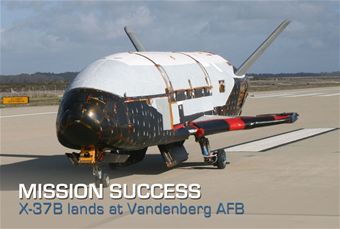By Kalwinder KaurJun 19 2012
Marking a triumphant accomplishment to a record-breaking test-flight mission that commenced March 5, 2011, from Cape Canaveral Air Force Station, Fla, the unmanned, reusable space plane of Air Force landed successfully at Vandenberg Air Force Base, Calif., in the early hours of June 16.
 The Air Force's unmanned, reusable space plane landed in the early morning of June 16 at Vandenberg Air Force Base, Calif., a successful conclusion to a record-setting test-flight mission that began March 5 from Cape Canaveral Air Force Station, Fla. (U.S. Air Force file photo)
The Air Force's unmanned, reusable space plane landed in the early morning of June 16 at Vandenberg Air Force Base, Calif., a successful conclusion to a record-setting test-flight mission that began March 5 from Cape Canaveral Air Force Station, Fla. (U.S. Air Force file photo)
For carrying out on-orbit experiments, the X-37B Orbital Test Vehicle remained 469 days in orbit.
The X-37B program manager, Lt. Col. Tom McIntyre says that the vehicle has been designed to perform 270 days-long mission. According to the first mission’s post-flight assessments, OTV-1 may have remained in orbit for more time. This mission’s objective is to devise ways to extend the on-orbit duration.
The X-37B program is coordinated by the Air Force Rapid Capabilities Office. This program includes experimentation, risk reduction, and operations development concept that support reusable space vehicle technologies. Following the NASA Discovery shuttle program, the X-37B mission is the longest space mission.
Weighing 11,000-lb, around a fourth the size of the shuttle, this advanced vehicle enables space technology experts to conduct the experiments consistently. The results however return to Earth securely for study.
McIntyre continues that the X-37B OTV program provides the space technology development with singular capability, following the completion of the space shuttle fleet. With this return capability, the Air Force can easily and efficiently test new technologies.
Primarily a NASA initiative, this vehicle was transferred to the Defense Advanced Research Projects Agency in 2004. Soon after its 2006 debut launch, the vehicle became renowned for its innovative technologies like the high-temperature components and seals, auto de-orbit capability, and thermal protection tiles.
Source: http://www.af.mil/
Disclaimer: The views expressed here are those of the author expressed in their private capacity and do not necessarily represent the views of AZoM.com Limited T/A AZoNetwork the owner and operator of this website. This disclaimer forms part of the Terms and conditions of use of this website.